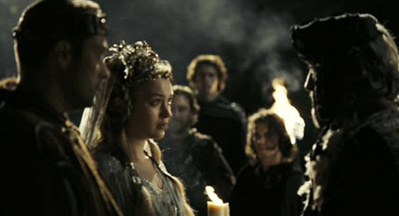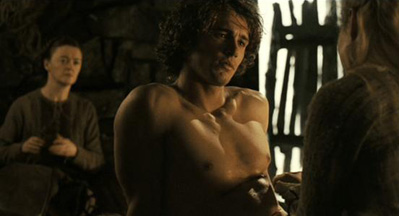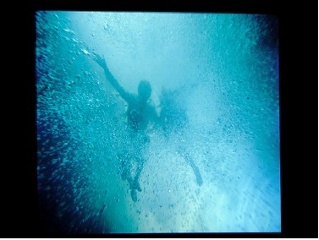Abstract
The story of Tristan and Isolde is one of the founding myths of Western culture and fifteen hundred years after its first appearance artists continue to embrace and re-write this early medieval tale, with Wagner’s 1865 opera Tristan und Isolde remaining a touchstone for contemporary reinterpretations. This paper examines two recent screen-based responses to the legend, Reynolds’ Hollywood film, Tristan + Isolde, and the video art works of Bill Viola, Love/Death: The Tristan Project, the ways in which “high” and popular culture feed into and on one another, and their role in creating Early Europe in our screen imagination.
…..
Medieval scholars are dubious about films set in the Middle Ages. Historians are “troubled and disturbed” by historical films.[2] So as a Germanist and Performance Studies scholar, surely I too must be ambivalent about the exposure of Tristan and Isolde to the inevitable degradation of an encounter with the screen? This is, after all, not only “the greatest love story that ever has and probably ever will be created in world literature”,[3] but we are countenancing what is clearly a very serious disciplinary incursion, with low culture edging its way into the terrain of high…
Preserving such rigid, and by implication hierarchical, disciplinary boundaries was long common practice in academia. Just as, however, some medievalists have come around to the notion of the validity of studying “medieval” film, I propose here that such interdisciplinary boundary-riding can progress further, addressing issues of both form and genre. The place of popular film in the field of medievalism has been firmly established, and such films closely examined, but we might also consider what could come from applying insights gained from such study to an expanded sense of the field. The richness of screen culture is not limited to film or television: video art is a powerful, if less often treated, manifestation of the form. Similarly, while the “low” culture side of the equation has been well served by such thorough investigations into the genre of popular film, “serious”, “high” culture video artworks have received comparatively little attention.
In 2006 two new screen-based encounters with the story of Tristan and Isolde premiered. One was the Hollywood film, Tristan + Isolde, directed by Kevin Reynolds, and the other was a video installation by the renowned video artist Bill Viola, Love/Death: The Tristan Project which stemmed from a production of the Wagner opera. In the following essay I will discuss how “high” culture feeds into, and on, popular culture and vice versa, and how this also occurs across the spectrum of screen-based works. The screen, moreover, offers a special feature not available to other forms of artistic expression: it offers a unique way of engaging with the past where the artists’ attitude to temporality becomes a feature of their form and, simultaneously, a commentary on it. We know that medieval films
rarely construct a historically accurate – or even historicized – version of the Middle Ages. In fact, they more frequently hybridise time periods so that multiple historical periods interlace and interact to facilitate transhistorical ‘realities’, thus constructing metacommentary on these time periods.[4]
A flexible, multilayered temporality thus becomes an essential element of its construction. Pugh and Ramey are largely drawing their examples and conclusions from popular medieval film, but this collapsing of the historical and/into the mythological is a phenomenon applicable to, and used to great effect in, other screen-based forms. So, for example, Bond can claim that “[o]ne of the defining characteristics of video and film is its temporality and its linearity”[5] – and go on to note that “the key to much of Viola’s work is how he modifies these elements”. Time, as it is portrayed, experienced and re-framed within these works makes possible our “continuous return” to the “Middle Ages”, all the while revealing our contemporary selves to ourselves.
Wagner, film and the Middle Ages
Many people know the story of Tristan and Isolde only through Richard Wagner’s opera, Tristan and Isolde, which premiered in 1865. Based on Gottfried von Strassburg’s narrative poem Tristan,[6] it was written following a period of renewed interest in the story, and medieval literature generally, among German writers in the early nineteenth century. The essence of this story which has had countless incarnations (including, from the later Middle Ages, as a strand of the King Arthur tales)[7] is that of a love triangle: the Irish princess Isolde is promised to King Mark (Tristan’s uncle or father figure), but loves Tristan whose life she has saved by healing a wound sustained when he killed (her uncle or fiancé) Morholt. The lovers are discovered and ultimately Tristan, and usually Isolde, dies.
Wagner’s fascination with medieval texts and themes resulted not only in Tristan und Isolde, but also Parsifal(1882) and, most famously of all, his Ring cycle (1876). He was arguably the most important reimaginer of the Middle Ages in his own time, and this influence persists today. Wagner’s Tristan und Isolde has become the major point of reference for contemporary artists engaging with the story even now into the twenty-first century. Artists almost inevitably have to acknowledge him (even if only to distance themselves from him and his works) when engaging with material he has already touched: we reach back to the Middle Ages through nineteenth-century Romanticism. We might then place this alongside D’Arcens’ claim that:
cinema (and to a lesser extent television) has remained the most aesthetically exciting and ideologically powerful medium for expressing the contemporary fascination with, and reinvention of, this [medieval] period.[8]
A (still) profoundly influential nineteenth-century artist and a ubiquitous twentieth-century art form: both contribute in significant ways to a continuing celebration and reanimation of a distant past.
I am not the only person to think that Wagner, the revolutionary theatre-maker, would have delighted in the possibilities offered by that artform which postdated him: others have also recognised Wagner’s essentially cinematic imagination.[9] And film does seem to have a special affinity with Wagner, his music and the Middle Ages. Harty reminds us that Thomas Edison’s Parsifal (USA 1904) is, in fact, “the oldest surviving example of cinema Arthuriana”, and six films of, or based on, Wagner’s medieval operas were among the earliest films made.[10] We have also absorbed Wagner, consciously or not, as the musical accompaniment to many “medieval” films such as Excalibur (USA/UK 1981), Lord of the Rings (NZ/USA 2001) and even Star Wars (USA 1977):[11] so naturalised has the fit of nineteenth-century classical music become with filmic representations of the Middle Ages that it is only when this peculiar custom is obviously flouted that we notice it.[12]
The Tristan story itself has been also enthusiastically embraced by film from very early on in its history: the first film, Tristan et Yseult, was made in France in 1909. By 2002 there were at least thirteen films which were based on the legend, plus a two-part film made for television.[13] The 2006 Reynolds film is thus the latest in a long tradition of Tristan films, and now opera is now also engaging with the screen in innovative ways. In this paper I will begin by analysing Tristan + Isolde, pointing to the ways in which it draws on its place within the genre of medieval film, but also simultaneously occupies a position within the Tristan and Isolde tradition, including as an heir to Wagner’s version. I will then discuss Love/Death: The Tristan Project, reflecting on how it, specifically conceived as a companion and response to Wagner’s Tristan und Isolde, and later reconceived as an independent screen-based artwork, might also offer insights into these questions, and the ways in which it and the popular film may be productively read against one another. There is an almost incestuous feedback loop between Wagner, the Middle Ages, the famous lovers and their presentation on screen, which offers a fascinating place from which to explore how “Early Europe” is constructed in, and constructs, our screen imagination.
Tristan + Isolde
Its makers might be surprised to know that in this film they created more than summer holiday viewing for bored teens: Tristan + Isolde is a lovely example of the genre of “medieval” film. It follows patterns identified by writers such as Haydock, Woods and Lindley[14] which help construct the genre and make it readable to an audience. As for any genre this will rely in part on “prior textualisation”[15] and in this instance this will have implications for such things as its marketing, casting, construction of temporality and story patterns, all of which are created in relation to a complex web of previous incarnations of the story in question, analogous stories, other “medieval” material and so on, as well as extra-narrative elements such as the background and prior film-making history of the film’s creators.
Even before its release Tristan + Isolde’s marketing called on audience expectations and previous knowledge of the genre: it was hyped as “before there was Romeo and Juliet there was Tristan + Isolde”. Its title works instantly on a potential audience: the lovers we already know, the similar pairing of the names and, more subtly, the typography to connect this to a previous movie hit. It is not Tristan and Isolde, nor Tristan & Isolde: the plus sign was the hallmark of Baz Lurhmann’s Romeo + Juliet (USA/Australia 1996), marking it with ‘groovier’ than standard typography, and also gesturing towards the graffiti of teenage lovers (“Romeo + Juliet 4EVA”). The Luhrmann film openly asserted that this was “the greatest love story the world has ever known”, so the marketing of the later film asserted its place in relation to (or indeed as pre-empting) this.
Medieval film commonly cross-fertilises in this way to create itself, and this extends to casting practices: actors may be cast across movies in a way that enhances the creation and validity of the “medieval” world. Sean Connery, for example, has been described as “the reigning king of the Hollywood Middle Ages” ;[16] he has played King Arthur, King Richard the Lionheart, Robin Hood, the Green Knight, Brother William of Baskerville and a dragon, among other medieval roles. This practice is also apparent in some of the Tristan films. Nicholas Clay was cast as Tristan in Donovan’s film Tristan and Isolt (Ireland 1979), and two years later as Lancelot in Excalibur[17] – the ‘same’ role if we consider the love triangle of Tristan/Isolde/Marke is traditionally twinned with that of Lancelot/Guinevere/Arthur in the Arthurian tradition of the story. Rufus Sewell was an inspired piece of casting as Marke in Tristan + Isolde: he had previously played the evil Count Adhemar in A Knight’s Tale (USA 2001). In that film he wants a beautiful noble lady for himself; his much younger rival also falls in love with her and this is played out through the film. This creates a sense of visual continuity for an audience watching Tristan + Isolde and it codes Sewell’s character as immediately readable. In A Knight’s Tale all ends well as Adhemar is defeated and the young man wins his lady, but an audience is primed for Sewell to play the older nobleman who will stand in the way of Tristan and his beloved, five years later.
… And nine hundred years earlier. The films are set in the fourteenth and fifth centuries respectively, but this collapsing of earlier eras into an amorphous, undifferentiated “once upon a time” deep past is a distinctive feature of the ways such films are both made and consumed.[18] Executive Producer Ridley Scott selected director Kevin Reynolds for Tristan + Isolde on the basis that
[h]e’s a great filmmaker, and I just thought he does well with period stuff. You know, not just a romp like Robin Hood [Prince of Thieves], which was a pretty big one, a pretty successful one, but I also liked his version of The Count of Monte Cristo.[19]
Thus films set in the twelfth and nineteenth centuries became Reynolds’ passport to a fifth-century romance. Viewers will go along with this: the trick is for film-makers to maintain “decorum” as Woods puts it.[20] Our knowledge of what is “medieval” is constructed from all the previous medieval films we have seen – Haydock’s “prior textualisation” – and this gives film-makers a broad range of acceptable castles, armour, peasants and princesses to draw on; or as film critic Jonathan Rosenbaum has said: “It doesn’t matter if the historical details of the film are authentic. They just have to look authentic.”[21] It is thus only where there is a really glaring error (anachronism and accent are often the main culprits) that we may resist the world we have been invited to participate in.
In Tristan + Isolde one could list many anachronisms. But how many viewers are really bothered by the fact that they didn’t use forks or stirrups in the fifth century; that “England” did not exist at the time; that Isolde recites the poetry of a man born 1000 years later; or even that she’s clearly wearing contact lenses in one scene? Many won’t recognise these at all (I didn’t), and for those who do, these elements may even play a positive role in creating the then/now time of medieval film: it may be taking place ‘then’, but is actually telling us about ‘now’. As Lindley puts it, “so often with films of the Middle Ages, for twelfth century we must read twenty-first”.[22] This is of particular relevance for an ancient story like Tristan and Isolde’s because a twenty-first century version will inevitably take on at least some of the historical, political and artistic conventions, anxieties and preoccupations of our own time.
As well as conforming with the temporal conventions of this genre, Tristan + Isolde also works structurally to maintain others of its authenticating conventions.[23] So, for example, like many others, the film opens with a scroll locating and framing the following story:
Britain the Dark Ages
The Roman Empire has fallen.
The land lies in ruins, divided among feuding tribes.
To the west, Ireland has flourished untouched by the Romans, protected by the sea.
Led by their powerful and ruthless King, the Irish have subdued the Britons.
Knowing that if Ireland is to prosper, the tribes must never be allowed to unite.
Then, Woods tells us, we will plunge straight into the action, often “in company with someone on a journey”[24] – and lo and behold, we see the boy Tristan and his father in a wild mountainous landscape, journeying home after hunting. The scene is set for Tristan to witness the butchering of his parents by the Irish; to be saved, and then raised, by Marke; and from there to follow the appropriate trajectory wherein we have empathy for the hero’s dilemma; the hero is reflective and suffers pain, and all depends upon him; and loyalty, faith and identity are absolutes. We, through the hero, are “transfixed inescapably by the necessity of doing what we must, believing as we do, being who we are”.[25] This Tristan wobbles a bit on the count of being “reflective”, but he does come good in the end – indeed, the manifestation of his re-assertion of loyalty brings about a significant change to the conventional ending of this story.
The film ticks the boxes to take its place within its genre, but it also needs to function within its own narrative history, and to do the ideological work of its own era as well. Everyone loves a love story, and makers and commentators are quick to claim the “greatest love story ever told” tag, but such “timeless” stories are actually “time-full”, and firmly rooted in our present. The broad narrative outlines must remain constant as this allows us to connect to the tradition, and feel part of a long chain of like-minded readers and viewers stretching back to a distant, misty past, but the ways the stories are inflected also locate them in a specific here and now.
Tristan + Isolde is both “like” and “not like” Wagner’s version of the tale in a number of significant ways. It is indebted to it for its title and character names,[26] and Wagner’s influence has been explicitly or implicitly acknowledged in a variety of reviews and commentaries. Some have claimed, for example, that the film is “a non-operatic rendition of Richard Wagner’s Tristan und Isolde”,[27] and in other instances specific elements which Wagner introduced to the story have been retained, like having Morold/Morholt as Isolde’s fiancé rather than uncle.
In other cases, though, aspects of Wagner’s plot have been deliberately excluded – for example, where Tristan and Isolde mistakenly drink a love potion, believing it to be poison: there is no love potion at all in this version.[28] Another significant diversion from Wagner occurs at the film’s ending where Marke relents in time for Tristan and Isolde to be reunited before just Tristan dies. For Wagner this was a transcendental love that was too big for this earth – it needed to be fulfilled by both in death; but in a contemporary era of youth-focussed demand for instant gratification such a concept would verge on the ridiculous. Such an important change requires massaging of the original story. Reynolds may here take his cue from another Camelot film to resolve his own: First Knight(USA 1995) is unusual in that the adulterous relationship between Lancelot and Guinevere does not cause Camelot’s downfall, and the film ends with Lancelot, Guinevere and Arthur reconciled. For Tristan + Isolde the ending, if not exactly happy, is similar (they are reconciled, but Tristan rather than Marke ends up dead), and by no means as disastrous as is usually the case. In the medieval versions, and followed by Wagner, both Tristan and Isolde die: Marke has lost his legacy and his love – it’s wrecked his rule and his family. This time, though, Tristan’s brave actions in battle have saved the kingdom, and Isolde does not die, but it does require an explicit scroll at the end to confirm this change in outcome:
Their love did not bring down a kingdom.
Legend says that Marke defeated the Irish,
rebuilt Castle D’or and reigned in peace
until the end of his days.
Isolde laid Tristan beneath the ashes of the
Roman ruin, planted his grave with two
willows that grew forever intertwined…
then disappeared.[29]
The interweaving willow trees reinforce Tristan and Isolde’s ‘place’ by the water’s edge, about which I will write further below, and their eternal inseparability, thus paying heed to the traditional conventions of the story. But Isolde’s disappearance is unconventional. It nevertheless conforms to the logic of this 2006 film: although Marke is not portrayed as evil, it is still inconceivable to modern audiences (and the rules of popular romantic film story-telling) that Isolde would return to him following the death of Tristan. Instead we are offered the Sliding Doors scenario; the “what if” alternative path that might have been taken. That is: if Tristan had not encountered Isolde he would have died of his first wound, rather than the later one. If Isolde had not stumbled across Tristan on the beach, dying of that first wound, then she too would have carried out her original intention to leave her father’s kingdom to avoid a marriage with Morholt. Immediately before spotting Tristan we have seen her striding purposefully down the beach with her maidservant:
BRAGNAE: Where are we going?
ISOLDE: Away.
It thus then makes perfect sense for Isolde to “disappear” at the film’s conclusion; the Isolde of “Tristan and Isolde” no longer exists and Isolde has instead moved back into her initial trajectory of setting out for somewhere else (however unlikely this may have been for an actual fifth-century adulterous wife).
This is a major – and modern – deviation from the traditional story, and it is one which anchors the film very specifically in its own time and place, and in relation to its audience. Young women are the major targeted audience for such Hollywood films, and for blockbuster success, the film’s sensibility must mirror that of its potential viewers. From the early versions of the story where Isolde’s name did not even feature in the title (medieval accounts were mostly just entitled Tristan), she is most definitely written into this story. She actively resists what was traditionally her fate – to be traded as a political pawn, passed from father to husband – and she is no submissive, passive heroine. We see this especially in terms of how Tristan is portrayed: he, more than she, is shown as the object of desire in the film, complete with lingering shots of his half-naked body with its rippling abdominal muscles. It is her gaze which ignites the sexual currents passing between them thus, unusually, also inviting the teenage girl audience also to share this point of view.
What’s more, this Isolde lives to tell the tale. Again Luhrmann’s film provides a model for this: he allowed Juliet to re-awaken from her coma before Romeo swallows the fatal poison, giving us a fleeting moment of suspension where it is conceivable that the heroine does not, after all, always die of love at the end of the story. Remaining true to Shakespeare’s text, however, he doubly reinforces the inevitability of the outcome by then having Juliet die to the strains of Wagner’s Liebestod, thus explicitly harnessing together these stories. In earlier versions of the Tristan tale Isolde only just survives Tristan and promptly dies of grief, but here, in the same way that it would be inconceivable for her to return to Marke, it would also be unbelievable for her to “die of grief”. She may technically be living in the fifth century, but she is also co-habiting the twenty-first. The film’s writer originally envisaged that Isolde would survive and live into old age, and the film would be narrated by her as an old lady. While this did not come to pass, the final scroll hints at it.
I would like to look briefly at one final recurring symbolic element which plays a critical role not only in this film, but also in other incarnations of the story.[30] Water frames this story in a number of significant ways and makes possible a number of crucial plot points. To begin with, and this is an element common to all versions of the story, Isolde and Tristan are initially separated by a sea and it is bridging this sea that brings them (and their countries and kings) together. In this film, both of them are “at home” by the water: Isolde’s home is located right on the shore, Marke’s castle on a river. The water begins as the barrier between their two worlds, Ireland and Cornwall, but is soon transformed into a more permeable, liminal zone for them personally. Their meetings, and partings, take place there. They first encounter one another, and fall in love, on the shoreline – and when they continue to meet after Isolde’s marriage to Marke, it is by the river. It is an in-between place, outside the structures and rules of their daily life; a place where they can escape an unbearable reality. This harnesses their love, by analogy, to the powerful, uncontrollable elemental forces of nature and in this way underlines its inevitability. In keeping with this, their story also ends by the water: Tristan is taken outside the battlements of Marke’s castle to die on the riverbank; the river sweeps past him and Isolde. We see them in close-up and all we can see behind them is the flowing water. Their image fades out and all that remains is the rippling water. It is a beautiful image and one which is strongly echoed in Viola’s video art work.
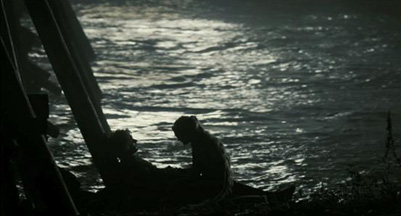
Love/Death: The Tristan Project
As mentioned above, many have commented on Wagner’s supposedly cinematic imagination, so it is perhaps surprising that this production of Tristan und Isolde was “a project unique in the history of opera”:[31] it was the first time that a video artist had created a setting for an opera. The production, directed by Peter Sellars and with full-length videos created for it by Viola, had its premiere at the Opéra National de Paris in 2005.[32] The following year, Love/Death: The Tristan Project, an installation of reworked pieces from the video works, with its own soundtrack, was exhibited in London.[33] In 2008 three extracts from Love/Death: The Tristan Project were shown in Sydney (under the banner The Tristan Project): Fire Woman and Tristan’s Ascension (The Sound of a Mountain Under a Waterfall) at St Saviour’s Church, Redfern and The Fall into Paradise at the Art Gallery of New South Wales. It is this Sydney incarnation of the project, and in particular the last piece, on which I will concentrate here.
The opera production, including its video setting, was generally well received, but there was also a degree of consensus among critics that the most literally illustrative images were the least successful.[34] Viola chose to focus on the less literal, more evocative images when he set out, following the production of Tristan und Isolde, to “create a series of video art works independent of Wagner’s music”.[35] Indeed when he had first listened to the Wagner opera he was “in shock” at the “bombastic music” and the “huge tsunami of ego”, wondering what he had got himself into.[36] He went back to the story itself for inspiration for his work on the project, and later even went so far as to claim in one interview that the works were informed by his readings of Tibetan teachings on death and dying, rather than the Celtic mythology of the Tristan story.[37] In creating these works Viola turns to themes and ideas which have long preoccupied him, but an interest in Eastern spirituality, as well as with the story itself, are also things that he shares with Wagner. Thus, although technically detached from their Wagnerian origins and context here, these pieces nonetheless continue to resonate with it and thus, I would argue, also with other iterations of the Tristan story.
sI will begin by briefly describing the three pieces, giving a more detailed description of The Fall into Paradise.[38] Fire Woman and Tristan’s Ascension were both projected onto a 6 x 3 metre screen behind the altar of St Saviour’s. Fire Woman depicts a hooded woman, in silhouette, standing in front of an enormous wall of flames. After a time, she moves forward, arms outstretched, and falls forward into what we now see is a pool of water: the flames are eventually “quenched” by the water and ultimately the screen is filled with blue water. In Tristan’s Ascension (The Sound of a Mountain Under a Waterfall) we see the Tristan figure lying on a stone bier, dressed in white. A slow drip of water from above turns into a torrent, and Tristan is lifted up into it and gently propelled upwards, from the chest, to the top of the screen, whereupon he disappears.
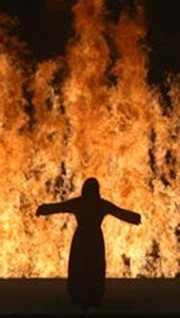 |
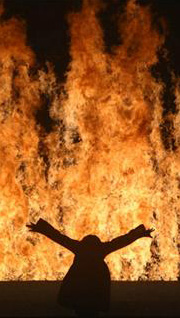 |
| Fire Woman, 2005. | |
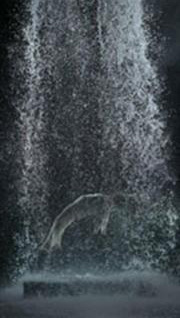 |
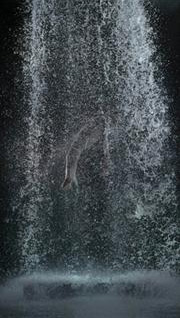 |
| Tristan’s Ascension (The Sound of a Mountain Under a Waterfall), 2005. | |
The Fall into Paradise begins with a single, tiny dot of light – perhaps the first star in an otherwise black universe. (Is this the beginning of the world?) Gradually it becomes a single-celled organism; in shape a crescent moon, a heart, a foetus as it grows and pulses. It splits into two, and then rejoins, clasping “hands”. Eventually, finally, we see that it is a man and a woman, embracing and dancing together. They look up above their heads and – disconcertingly – plunge upwards into the water: black and white changes to blue, the silence to the bubble and thrum of the ocean. Barefoot and in filmy clothing, they rise slowly towards the top of the screen. They no longer clasp one another’s hand; he breathes out bubbles and turns from her, leaving her. She reaches out to touch his back. They dissolve into the light.
Bond notes that this work is evocative of a number of Viola’s earlier works, especially in its use of underwater shooting techniques and the dramatic resulting effects of film being played in reverse and extremely slowly.[39] This one short piece of video art (it is about ten minutes long), tells a profound and moving story. Its title, of course, also primes us interpretatively: there are echoes of the original Fall – from grace and out of Paradise. It’s falling for one another that causes Tristan and Isolde’s fall. And, as is literally depicted here, there is a fall into another dimension/element, and possibly another state altogether, if the pair achieves Paradise by drowning. Certainly Viola, echoing Wagner, describes theirs as
a love so intense and profound that it cannot be contained in the material body of the lovers. In order to fully realise their love, Tristan and Isolde must ultimately transcend life itself.[40]
Both Viola and Wagner are preoccupied with the elemental, be this natural (fire and water) or of human experience (love, life and death). They are yoked here in their responses to the Tristan story which incorporate all of these. The Fall into Paradise, for example, tells a story from life to death – of an individual, from zygote to adult death, but also of this famous pair of lovers. Its primary medium is water and this inevitably connects us back both to Wagner. Wagner’s opera is structured around this element, both beginning and ending with it. The first Act takes place on board ship, with Tristan and Isolde making their way back to Cornwall from Ireland. In the opera the first voice we hear is the call of a young sailor; the last voice is Isolde, on the point of death, a death she characterises as drowning – “to drown, to sink/unconscious – supreme bliss!”.
Bracketed by water in the version to which he was, at least initially, responding, Viola makes this a feature of all three extracts shown here, and especially so in The Fall into Paradise. Replacing Wagner’s soundtrack with his own of lapping, bubbling and roaring water sounds reinforces its centrality. By presenting this work separately from the larger flow of images in its original context (and here in a separate building and context from the other two extracts) productively refocuses our concentration on it. It is almost as if Viola is asking us: what would happen if the lovers stayed on Act I’s boat, played out their passion and its deadly consequences there? If they short-circuited the Wagner opera and moved straight to its inevitable conclusion, the one we know with certainty must come?[41] I think, in fact, the other two video works might be hinting at this: both Fire Woman and Tristan in Ascension are immersed in water and thereupon vanish,[42] and each of the three pieces could easily be read as representing a ‘moment of death’. That this, however, is a positive thing, as Wagner’s opera directs us to believe, is also echoed here: The Fall into Paradise is literally uplifting – the figures swim ever upwards until they disappear – and the viewers are suffused with a sense of tranquillity and peace in watching the images that gently bubble and dance, ebb and flow before us.
Viola’s chosen imagery also, however, evokes other versions of the Tristan story, not least the concluding moments of Tristan + Isolde. The Fall into Paradise also strongly recalled to me an element of the Tristan story which does not appear in Wagner’s version but does, for example, in Rosemary Sutcliff’s novel Tristan and Iseult.[43] In one episode, she describes Tristan’s escape from being executed for his betrayal by hurling himself off a cliff and plunging into the sea far below in a “hero leap”, before dashing to rescue Iseult. In a pleasing coincidence, Iseult had been condemned to die “by fire, which by the law of the land was the proper punishment for a queen who had betrayed her lord”[44] which recalls Viola’s Fire Woman. In her “white shift, and her […] hair falling loose about her”,[45] she could also be the Isolde figure in The Fall into Paradise. Viola and Sutcliff seem both to have tapped into the same “medieval” imaginary.
A body hurling itself (romantically, heroically) into water is a powerful image, and one which is best, and most seductively, realised on screen. Luhrmann knew this when he set the famous balcony love scene between Romeo and Juliet beside – and in – a swimming pool. At the exact moment of their encounter, as they address their first words directly to one another, they topple into the pool. Immediately we too are plunged into this miraculous new blue “other” world of discovered love. It is, in fact, a telescoped version of Viola’s later artwork: the bubbling water, a shaft of bright piercing light, the lovers (Juliet in her long white shift and loose hair) ascending, entwined. In Tristan + Isolde too we have a reprise of one of the most memorable, and much quoted, recent examples of such a scene: when Isolde, in her pale grey gown, watches Tristan bathing in the sea, this is ghosted by the famous scene in the 1995 BBC Pride and Prejudice where Mr Darcy plunges into the lake to the delight of the viewer – and later Elizabeth, in her long, white dress.[46] As Darcy dives into the water, our perspective is instantly changed to being underwater: we see him plunge into, and upwards out of, the water – just as we do in Viola’s piece, and as just we did in Romeo + Juliet.
However much Viola would like to separate these works from Wagner, or indeed from an extended tradition of which they are part, this is impossible, thanks to the ‘readers’ of the work who will make such connections and the Western cultural unconscious upon which they draw to do so. One reviewer wrote of Tristan’s Ascension (as used in the opera production) that:
As a piece of imagery this is extraordinary: primordial and poetic. Without actually illustrating anything, it suggests all manner of things – the flight of seraphim, the rushing waters of the creation and the flood. All of Viola’s Tristan pieces are like that. They don’t illustrate Wagner’s opera but they engage with the underlying symbolism of the composer’s world.[47]
It is through these associative images that Viola is thus most powerfully connected to Wagner’s artwork. But paradoxically they are also the extracts which best stand alone because they speak to broader themes and experiences and allow an audience member to read it across other experiences, memories and visual references.
Here too is where popular film and video art come together, even if it is usually framed in different ways. What might be identified in popular film as an ‘in-joke’, or even dismissed as superficial self-referentiality within the genre, becomes, when it is screen-based ‘art’, an “associative image” or “allusion”, “symbolic” or “archetypal”.[48] Both strategies play the same role, however; it’s about audience recognition of pattern and prior reference. Artworks such as Viola’s might do this in a less immediately obvious way than popular medieval film, but the screen has become a place for the creatives of our time – Hollywood film directors or video artists[49] – to contribute to, quote, reference and connect to a fifteen hundred year old story. Viola himself has said “[e]ach generation has to find a way to realise enduring, archetypal images that are understandable to it”,[50] and the screen offers a unique way for artists to explore this, through its ability to engage with and manipulate temporality on a number of levels. Both forms ultimately thus share an ability to create present-in-the-past in order to be able to explore a past-in-the present; that is, a celebration of an unchanging same-ness of, and connection between, then and now, moderated by contemporary mores, and motivated by (for us) enduring values, like love, honour, loyalty, self-sacrifice and death, which are (we feel) common to all humans at all times – or at least as far back as the Middle Ages, which seems to be the outside limit of ‘our’ past. Perhaps this is why, as Eco has noted,
people started dreaming of the Middle Ages from the very beginning of the modern era. […] Modern ages have revisited the Middle Ages from the moment when, according to historical handbooks, they came to an end.[51]
Endnotes
[1] Umberto Eco, “Dreaming of the Middle Ages”, in Travels in Hyperreality: Essays, trans. William Weaver (San Diego: New York: London: Harcourt, 1983 (1973)), 65.
[2] See Robert A. Rosenstone, “The Historical Film: Looking at the Past in a Postliterate Age”, in The Historical Film: History and Memory in Media, ed. Marcia Landy (London: The Athlone Press, 2001), 50.
[3] Renée L. Curtis, “Wagner’s Tristan und Isolde: The Transformation of a Medieval Legend”, Tristania VIII, no.2 (Spring 1983): 13.
[4] Tyson Pugh and Lynn T. Ramey, “Introduction: Filming the ‘Other’ Middle Ages”, in Race, Class, and Gender in ‘Medieval’ Cinema, eds. Lynn T. Ramey and Tyson Pugh (New York: Houndmills (Basingstoke, Hampshire): Palgrave MacMillan, 2007), 6.
[5] See Anthony Bond, Untitled essay, in Bill Viola: The Tristan Project (Sydney: Art Gallery of New South Wales, 2008).
[6] Gottfried based his Tristan on the earlier Roman de Tristan by Thomas d’Angleterre, an Anglo-Norman text dating from some forty to fifty years earlier. Gottfried’s Tristan was left unfinished at his death in 1210. By strange coincidence we have the first five-sixths of the story from Gottfried and only the last sixth of Thomas’s version survives, giving us thus more or less the complete story.
[7] See, among others, the following for accounts of re-tellings of this myth: Ulrich Müller, “The Modern Reception of Gottfried’s Tristan and the Medieval Legend of Tristan and Isolde”, in A Companion to Gottfried von Strassburg’s Tristan, ed. Will Hasty, Studies in German literature, linguistics, and culture. (Rochester (NY): Woodbridge (Suffolk): Camden House, 2003); Michael S. Batts, “Tristan and Isolde in Modern Literature: L’éternel retour”, in Tristan and Isolde. A Casebook, ed. Joan Tasker Grimbert (New York: Garland Publishing, 1995).
[8] Louise D’Arcens, “Screening Early Europe” special issue proposal, 2009.
[9] See for example, Martin Gayford, “Time Bending Backwards – and a 50ft Wall of Fire”, Telegraph.co.uk, 17 June 2006. http://www.telegraph.co.uk/culture/art/3653171/Time-bending-backwards—and-a-50ft-wall-of-fire.html (accessed 4 September 2009); Reese Thompson, “Music in Review”, Yale Review 96. vol. 1 (January 2008): 189-90; Jane Moss, “The Best Things Happen to Those Who Wait”, program notes, The Tristan Project, New York: Lincoln Center for the Performing Arts, 2007. http://www.lincolncenter.org/programnotes/gp-tristan-050207.pdf.
[10] See Kevin J. Harty, “Cinema Arthuriana: An Overview”, in Cinema Arthuriana, ed. Kevin J. Harty, Rev. ed. (Jefferson (North Carolina): London: McFarland & Company, 2002), 7-8.
[11] See Tom Henthorne, “Boys to Men: Medievalism and Masculinity in Star Wars and E.T.: The Extra-Terrestrial”, in The Medieval Hero on Screen, for a discussion of Star Wars as “a neomedieval romance”.
[12] See for example Haydock, “Arthurian Melodrama”, 37, n.44.
[13] See: Müller; Harty, “Cinema Arthuriana: An Overview”; and http://www.imdb.com/title/tt0300576/(accessed 4 September 2009) which lists a full-length animated film (Tristan et Iseut (Tristan and the Princess of Irelandis) (France 2002), dir. Thierry Schiel) not included in the other sources.
[14] William F. Woods, “Authenticating Realism in Medieval Film”, in The Medieval Hero on Screen; Arthur Lindley, “Once, Present, and Future Kings: Kingdom of Heaven and the Multitemporality of Medieval Film”, in Race, Class, and Gender in “Medieval” Cinema.
[15] The term is used by Haydock (quoting Frederick Jameson) to suggest that “no representation of an historical Middle Ages can be independent of earlier film representations” (33, n5).
[16] Haydock, “Arthurian Melodrama”, 18.
[17] Noted in Harty, The Reel Middle Ages, 264.
[18] Even “medieval” films set in the present day or future times will gesture towards this past. Haydock has noted, for example, that in Romeo + Juliet (written in the 1590s) “Baz Luhrmann’s street gangs […] tote silver-plated automatic pistols engraved with the words “sword” or even “Excalibur” (“Arthurian Melodrama”, 18). We might think of Star Wars’ light sabres which function as swords in the same terms.
[19] Reg Seeton, interview with Ridley Scott,http://www.ugo.com/channels/dvd/features/tristanandisolde/interview.asp. Scott had, incidentally, intended a Tristan film to be his second film in the late 1970s (but ended up doing Alien instead) and was prevented from working on this Tristan + Isolde by his engagement with his own medieval epic, Kingdom of Heaven (2005).
[20] Woods, “Authenticating Realism in Medieval Film”, 47.
[21] Quoted in Martha W. Driver, “What’s Accuracy Got to Do with It? Historicity and Authenticity in Medieval Film”, in The Medieval Hero on Screen, 20.
[22] Lindley, “Once, Present, and Future Kings”, 16.
[23] See Woods, “Authenticating Realism in Medieval Film”.
[24] Woods, “Authenticating Realism in Medieval Film”, 42.
[25] Woods, “Authenticating Realism in Medieval Film”, 49.
[26] So does an Irish heroine, whose name first appears in Welsh tales, make her way into an Anglo-Norman story and from there into a Middle High German poem to finally settle in a nineteenth century German opera whose fame is so ubiquitous that even when a Hollywood movie is made, setting the story in Ireland and Cornwall, her name retains its Germanic flavour, rather than the Celtic versions, Yseult or Iseult.
[27] See http://en.wikipedia.org/wiki/Tristan_&_Isolde_(film) (accessed 4 September 2009).
[28] At one point in the writer’s commentary to the DVD of the film, Dean Georgaris notes that “in the most popular, sort of original version of the story, Tristan and Isolde make love on the boat on the way back, shortly after swallowing love potions that they thought were death potions”. This is a clear reference to Wagner (as this particular twist to the story is his invention), but Georgaris does not acknowledge the source.
[29] This was included by the director: the writer was surprised to see it in the final version of the film.
[30] And indeed the parallel story of Luhrmann’s Romeo + Juliet: that film is riddled with images of water, including the first moment we see Juliet, and the moment when Romeo and Juliet first catch sight of one another, through a fish tank.
[31]See Gayford, “Time Bending Backwards”.
[32]The work had premiered in concert form in 2004 under the title The Tristan Project at Los Angeles Philharmonic’s Walt Disney Concert Hall.
[33]At the Haunch of Venison Gallery and St Olave’s College.
[34] See for example: Thompson, “Music in Review”, 195; Matthew Westwood, “Space for Cool, Clear Visionary”, The Australian, 10 April 2008.
[35] Bill Viola, “The Tristan Project”, in Bill Viola: The Tristan Project (Art Gallery of New South Wales: Sydney, 2008).
[36] Quoted in Gayford, “Time Bending Backwards”.
[37] See Joyce Morgan, “Artist’s Baptism of Fire – and Water”, Sydney Morning Herald, 10 April 2008.
[38]It is also the only one I have seen “live”, so to speak, rather than relying on commentary from the artist, still images, very bad pirated copies of the video art work, and reviews.
[39]See Bond in Bill Viola: The Tristan Project.
[40]See Viola, “The Tristan Project”.
[41]In the full production of the work, it seems that this piece was set right at the critical moment when Tristan and Isolde drink the love potion in Act I and extends through to their first great love duet. See Alex Ross (“Bill Viola’s Tristan”. The New Yorker, 30 May 2005) for a review of the Paris production which describes this sequence.
[42] Both Fire Woman and Tristan’s Ascension are presented in essays and reviews in London and Sydney as preceding The Fall into Paradise, and yet it seems that the two actually followed The Fall in the opera production: Ross places The Fall into Paradise in Act 1 and Gayford describes Tristan’s Ascension as being accompanied by the Liebestod which is at the very end of the opera. Publicity material from the Art Gallery of New South Wales indicates that Fire Woman and Tristan’s Ascension occurred “in sequence at a climactic section late in Wagner’s narrative”. (http://www.artgallery.nsw.gov.au/media/archives_2008/bill_viola(accessed 4 September 2009)).
[43]Rosemary Sutclifff, Tristan and Iseult (Oxford: Heinemann, 1971). It also occurs, for example, in Swinburne’s “Tristram of Lyonesse” and Bédier’s The Romance of Tristan and Iseult.
[44] Sutcliff, Tristan and Iseult, 79.
[45] Sutcliff, Tristan and Iseult, 85.
[46] The same scene is parodied (with Firth reprising his role) in the 2007 film, St Trinian’s. Mr Darcy/Colin Firth’s iconic status was cemented when Firth played “Mr Darcy” in the film versions of the Bridget Jones’ Diary novels (2001 and 2004). The novelist Helen Fielding apparently based her books on both Pride and Prejudice and the BBC television series… and the screenplay in turn was written by the same writer who adapted Austen’s novel for the BBC (see http://en.wikipedia.org/wiki/Bridget_Jones’s_Diary_(film)) (accessed 4 September 2009)). The 2008 ITV miniseries, Lost in Austen, has a present-day heroine who travels through time/fiction to the world of Pride and Prejudice and has Mr Darcy “re-enact” the lake scene for her benefit!
[47] Gayford, “Time Bending Backwards”.
[48] See for example Bond in Bill Viola: The Tristan Project, where he notes that
[t]he mirror-like surface of water is associated with powerful metaphysical ideas in many cultures. […] Viola’s videos symbolise these primal associations, touching on deeply embodied memories and cultural histories.
[49] Or indeed opera directors turned film directors: Luhrmann moves easily across the popular/high culture spectrum and openly indicates to his audiences that he can equally apply his bag of tricks to either end – the famous “L’Amour” sign which featured large in his production of La Bohème for Opera Australia, and which later became a Broadway show hit, was then used in Romeo + Juliet (and made an appearance in his other films, Strictly Ballroom (Australia 1992) and Moulin Rouge (USA/Australia 2001)).
[50] Quoted in Morgan “Artist’s Baptism of Fire – and Water”.
[51] Eco, Travels in Hyperreality, 65.
Created on: Sunday, 20 December 2009

